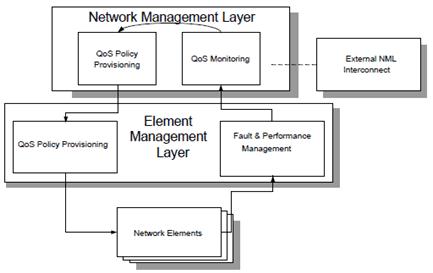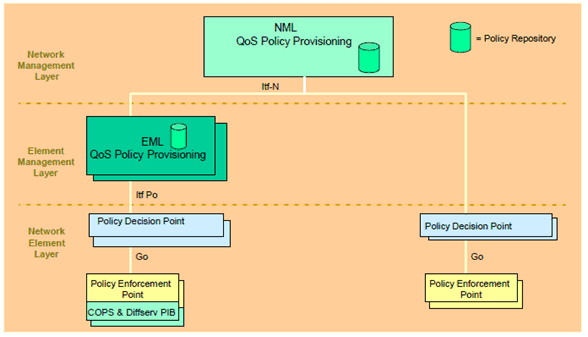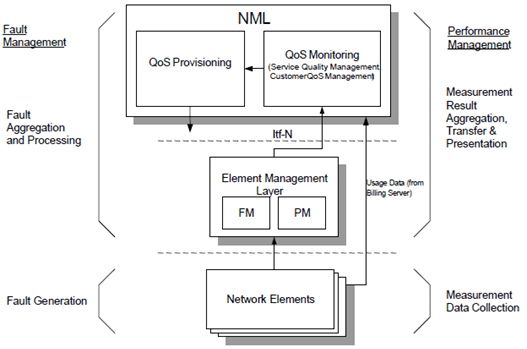Content for TS 32.101 Word version: 17.0.0
A 3GPP Management-application-layer-protocols
B 3GPP management network layer protocols
C 3GPP management IRP Solution Sets
D QoS Management
D.1 Overview
D.2 QoS Provisioning
D.3 QoS Monitoring
D.4 QoS Management References
E Type 2 protocols and information model for use in Type 4a management interface
$ Change history
A (Normative) 3GPP Management-application-layer-protocols p. 52
The valid Management-application-layer-protocols for 3GPP are:
- CORBA IIOP (see references [8] and [52]);
- NETCONF (see reference [118]);
- SNMP (see reference [6]);
- SOAP (see references [108] and [109]).
- FTAM (see references [13] - [19]);
- ftp (see reference [4]);
- tftp (see reference [5]);
- sftp (secure ftp).
- TR-069 (see reference [115])
B (Normative) 3GPP management network layer protocols p. 53
The valid network layer protocols for the management of 3GPP are:
- IP (see reference [48];
- X.25 (see reference [22]).
C (Normative) 3GPP management IRP Solution Sets p. 54
The valid IRP Solution Sets for the management of 3GPP on the Itf-N and Itf-P2P interfaces are:
- CORBA (IDL);
- SOAP (WSDL).
- WSDL 1.1 [117];
- SOAP 1.1 [108].
D QoS Management |R4| p. 55
D.1 Overview p. 55
QoS Management, from an OAM&P perspective, in 3GPP systems primarily consists of two functional areas: QoS policy provisioning and QoS monitoring. QoS Policy Provisioning is the process of configuring and maintaining selected Network Elements with QoS policies that are created based upon customer SLAs and observed network performance. QoS Monitoring is the process of collecting QoS performance statistics and alarms; this data is then used to generate analysis reports for making changes/upgrades to the network. The detailed relationship between SLA Management and QoS Provisioning and Monitoring is for future study. A conceptual breakdown of QoS Management is shown in Figure D.1.

The following clauses provide descriptions of QoS Provisioning and Monitoring.
It should be noted that the same descriptions could apply to other Policy Management instantiations, e.g. Security and Service Provisioning.
D.2 QoS Provisioning p. 56
D.2.0 Introduction |R15| p. 56
In the 3GPP systems, multiple network domains must inter-work in order to provide the end-to-end quality of service required by end-user applications. To add to this complexity, there are many classes of Network Elements from many network infrastructure suppliers, each of which require configuration in a consistent manner in order to the network operator's QoS objectives. Within each Network Element, there are many QoS functions (such as Admission Control, Policers, Shapers, Queue Manager and Scheduler), which must be configured.
In order to configure these heterogeneous networks so that they can deliver the desired QoS, the operator needs a management solution that meets the following high-level requirements:
www.ietf.org ,
- Automation of management tasks.
- Centralized management with fewer classes of management interface.
- Abstracted (or simplified) management data.
- End-to-End provisioning of the network.
- Consistent and uniform provisioning across all Network Elements.
- Standards-based solution in order to allow inter-operability at Network Element and OSS level.
- Scalable solution for large networks.
D.2.1 Conceptual Architecture p. 57
The conceptual architecture for a policy-based QoS Management System is shown in Figure D.2.

The architectural components identified in Figure D.2 are described in the following clauses.
The Itf N interface is specified in the 32 series.
The Itf Po, between the Policy Repository and the Policy Decision Point is to be defined. The protocols under consideration includes: LDAP, LDUP, SNMP and COPS-PR.
The reference point Go is defined in TS 23.207 (see D.4 QoS Management Reference [22]) and the interface implementing the reference point is defined in TS 29.207 (see D.4 QoS Management Reference [23]).
D.2.2 NML QoS Policy Provisioning p. 58
This is a network-level operational support function that serves as the policy administration point for the entire network.
The NML QoS Policy Provisioning provides the following functions:
- Network policy administration user interface
- Master network policy repository for storage of all network policies for all domains
- Policy distribution capability to distribute policy data to the EML Policy servers.
- Global policy conflict detection
D.2.3 EML QoS Policy Provisioning p. 58
This is an element management function that serves as the policy administration point for a network domain. A domain is an area of the network that contains equipment that performs a logically related function. Examples of network domains are: access network, core network and transport network, or supplier specific sub-networks within these networks.
The EML QoS Policy Provisioning provides the following functions:
- An optional EML-level policy administration user interface.
- EML-specific policy repository.
- Policy distribution capability to distribute policy data to the Policy Decision Points.
- Local policy conflict detection
D.2.4 Policy Decision Point p. 59
The Policy Decision Point is the point in the network at which policy decisions are made for the Policy Enforcement Points under its scope of control. Whereas the Policy Enforcement Point is a function within a network node, the Policy Decision Point is separate functional entity that may reside within a separate Policy Server, for example, on an application server. The Policy Decision Point will make decisions based on the policy information held within the Policy Repository.
The Policy Decision Point provides the following functions:
- Retrieval of Policy Information from the policy repository
- Evaluates the policy information retrieved and decides what actions needs to taken.
- Distributes policy data to the Policy Enforcement Points. This distribution can either be sent to the PEP by the Policy Decision Point or the Policy Decision Point can wait for the PEP to request the information.
- Translation from QoS policy schema employed by the policy servers to Policy Information Base (PIB) format employed by the Policy Enforcement Points.
- Optional real-time policy decision-making function.
- Local policy conflict detection
D.2.5 Policy Enforcement Point p. 59
The Policy Enforcement Point is a function that is part of a Network Element that must implement the policies defined by the policy administration system(s).
The Policy Enforcement Point provides the following functions:
- Storage of policy-related data locally.
- Execution of policies as network conditions dictate.
- Support for the Differentiated Services QoS mechanism (diffserv).
D.3 QoS Monitoring p. 60
D.3.0 Introduction |R15| p. 60
QoS Monitoring in 3GPP systems consists of collecting/processing performance statistics, usage data and QoS related faults. In order to obtain end-to-end quality of service monitoring, the Network Elements, the Element Management Layer and Network Management Layer must all be involved with the QoS Monitoring process. Alarm and performance collection is done at the Network Element layer and alarm/performance aggregation, report generation, and analysis is done at the Element Management and Network Management layers.
The following functions summarize the QoS Monitoring process:
- Manage QoS fault conditions received from Network Elements.
- Retrieve QoS Performance data from Network Elements.
- Collect and process usage data.
- Generate QoS Reports - trend analysis of key QoS parameters.
- Audit/Analyse collected QoS parameters against expected values.
D.3.1 QoS Monitoring Conceptual Architecture p. 60
The architecture of a QoS Monitoring system is shown in Figure D.3.

The architectural components identified in Figure D.3 are described in the following clauses.
D.3.2 Network Element p. 61
The Network Element component is responsible for collecting performance measurements, usage data and generating alarms. The Network Element component can contain the Policy Enforcement Point or the Policy Decision Point functions.
The Network Element component provides the following functions:
- Collect performance data according to the definition of the measurements and to return results to the EML.
- Collect usage data and forward the data to mediation
- Perform the following fault management functions: Fault detection, Generation of alarms, Clearing of alarms, Alarm forwarding and filtering, Storage and retrieval of alarms in/from the NE, Fault recovery, Configuration of alarms.
D.3.3 Element Management Layer p. 62
The Element Management Layer is responsible for aggregating and transferring the collected performance measurements and generated alarms/events.
The Element Management Layer provides the following functions:
Performance Management
-
Measurement data collection
- Measurement types. Corresponds to the measurements as defined in TS 52.402, TS 32.405, TS 32.406, TS 32.407, TS 32.408 and TS 32.409 (see clause D.4 of the present document on QoS Management Reference), i.e. measurement types specified in the present document, defined by other standards bodies, or manufacturer defined measurement types;
- Measured network resources. The resource(s) to which the measurement types shall be applied have to be specified
- Measurement recording, consisting of periods of time at which the NE is collecting (that is, making available in the NE) measurement data.
-
Measurement reporting
- Measurement Report File Format Definition
- The measurement related information to be reported has to be specified as part of the measurement. The frequency at which scheduled result reports shall be generated has to be defined.
-
Measurement result transfer
- Measurement results can be transferred from the NE to the EM according to the measurement parameters, and/or they are stored locally in the NE and can be retrieved when required;
- Measurement results can be stored in the network (NEs or EM) for retrieval by the NM when required.
-
Management of alarm event reports
- Mapping of alarm and related state change event reports
- Real-time forwarding of event reports
- Alarm clearing
-
Retrieval of alarm information
- Retrieval of current alarm information on NM request
- Logging and retrieval of alarm history information on NM request
D.3.4 Network Management Layer p. 63
From a QoS Monitoring perspective, the NML is responsible for the collection and processing of performance, fault, and usage data.
The NML QoS Monitoring layer provides the following functions:
- Service Quality Management: responsible for the overall quality of a service as it interacts with other functional areas to access monitored information, process that information to determine quality metrics, and initiate corrective action when quality level is considered unsatisfactory. Inputs to SQM include both performance and fault data.
- Customer QoS Management: includes monitoring, managing, and reporting the Quality of Service customers receive against what has been promised to the customer in Service Level Agreements and any other service related documents. Inputs to CQM include data from SQM and usage data.
D.4 QoS Management References p. 64
D.4.1 Policy Based QoS Provisioning References p. 64
The following documents apply to policy-based QoS provisioning:
[1]
www.ietf.org/rfc/rfc3060.txt
[2]
RFC 3060: "Policy Core Information Model - Version 1 Specification", Moore et al., February 2001.
http://
RFC 2251: "Lightweight Directory Access Protocol (v3)", M. Wahl, T. Howes, S. Kille, December 1997. http://www.ietf.org/rfc/rfc2251.txt
[3]
RFC 2940: "Definitions of Managed Objects for Common Open Policy Service (COPS) Protocol Clients" ,. A. Smith, D. Partain, J. Seligson. October 2000. http://www.ietf.org/rfc/rfc2940.txt
[4]
RFC 3084: "COPS Usage for Policy Provisioning (COPS-PR)"; K. Chan, J. Seligson, D. Durham, S. Gai, K. McCloghrie, S. Herzog, F. Reichmeyer, R. Yavatkar, A. Smith. March 2001. http://www.ietf.org/rfc/rfc3084.txt
[5]
RFC 2748: "The COPS (Common Open Policy Service) Protocol", J. Boyle, R.Cohen, D. Durham, S. Herzog, R. Rajan, A. Sastry. January 2000, http://www.ietf.org/rfc/rfc2748.txt
[6]
RFC 2753: "A Framework for Policy-based Admission Control", R. Yavatkar, D. Pendarakis, R. Guerin. January 2000. http://www.ietf.org/rfc/rfc2753.txt
D.4.2 Policy Based QoS Monitoring References p. 65
The following documents apply to QoS monitoring:
[7]
TS 32.101: " Telecommunication management; Principles and high-level requirements".
[8]
TS 32.102: " Telecommunication management; Architecture".
[9]
TS 32.401: "Telecommunication management; Performance Management (PM); Concept and requirements".
[10]
TS 32.200: "Telecommunication management; Charging management; Charging principles".
[11]
TS 32.205: "Telecommunications management; Charging management; 3G charging data description for the CS domain".
[12]
TS 32.215: "Telecommunication management; Charging management; Charging data description for the Packet Switched (PS) domain".
[13]
TS 32.600: "Telecommunication management; Configuration Management (CM); Concepts and high-level requirements ".
[14]
TS 32.111-1: "Telecommunication management; Fault Management; Part 1: 3G fault management requirements".
[15]
RFC 959: "File Transfer Protocol", J. Postel, J.K. Reynolds. Oct-01-1985. http://www.ietf.org/rfc/rfc0959.txt?number=959
[16]
RFC 1901: "Simple Network Management Protocol, v2", J.Case, K. McCloghrie, M. Rose, S. Waldbusser. January 1996. http://www.ietf.org/rfc/rfc1901.txt?number=1901
[17]
RFC 2573: "SNMP Applications", D. Levi, P. Meyer, B. Stewart. April 1999. http://www.ietf.org/rfc/rfc2573.txt?number=2573
[18]
RFC 1907: "Management Information Base for Version 2 of the Simple Network Management Protocol (SNMPv2)", SNMPv2 Working Group, J. Case, K.McCloghrie, M. Rose, S. Waldbusser. January 1996. http://www.ietf.org/rfc/rfc1907.txt?number=1907
[19]
TelemanagementForum (TMF) Telecom Operations Map (TOM), GB910, Approved Version 2.1, March 2000. http://www.tmforum.org/
[20]
TelemanagementForum (TMF) TOM Application Note, Mobile Services: Performance Management and Mobile Network Fraud and Roaming Agreement Management, GB910B, Public Evaluation Version 1.1, September 2000. http://www.tmforum.org/
[21]
TeleManagement Forum (TMF) NGOSS specifications http://www.tmforum.org/
[22]
TS 23.207: "End to End Quality of Service QoS Concept and Architecture".
[23]
TS 29.207: "Policy Control over Go interface".
[24]
TS 52.402: "Telecommunication management; Performance Management (PM); Performance measurements - GSM".
[25] Void.
[26]
TS 32.405: "Telecommunication management; Performance Management (PM); Performance measurements - Universal Terrestrial Radio Access Network (UTRAN)".
[27]
TS 32.406: "Telecommunication management; Performance Management (PM); Performance measurements - Core Network (CN) Packet Switched (PS) domain".
[28]
TS 32.407: "Telecommunication management; Performance Management (PM); Performance measurements - Core Network (CN) Circuit Switched (CS) domain".
[29]
TS 32.408: "Telecommunication management; Performance Management (PM); Performance measurements - Teleservice".
[30]
TS 32.409: "Telecommunication management; Performance Management (PM); Performance measurements - IP Multimedia Subsystem (IMS)".
E (Normative) Type 2 protocols and information model for use in Type 4a management interface |R8| p. 67
The 3GPP management detailed specification has defined protocols and information model (network resource model) for use across Itf-N, i.e. the Type 2 management interface. Some, not all, of these protocols and network resource model are applicable for use across the Itf-P2P, i.e. theType 4a management interface.
The following lists identify the Itf-N protocols and information model relevant for use across Itf-P2P. When certain part of a specific Interface IRP specification (e.g. a particular operation) is not applicable for Itf-P2P, that certain part shall be identified as Exception here.
- List of Interface IRP :
- [Names of Interface IRP, with possible Exception (see above), are included here. These are to be determined.]
- List of NRM IRP :
- [Names of NRM IRP included here. The names are to be determined.]